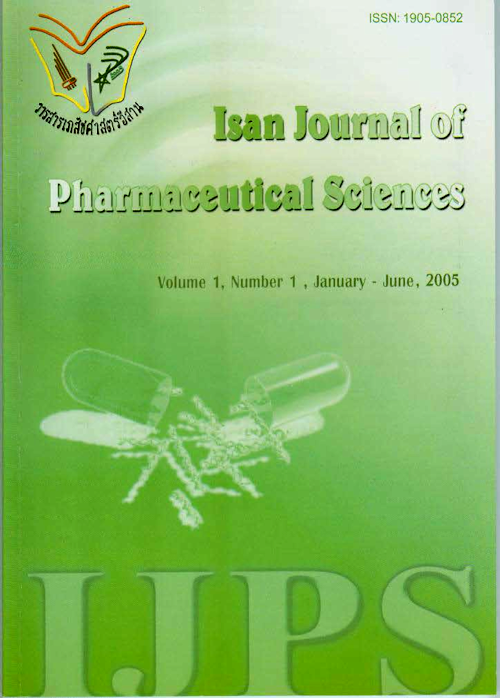Construct Validity of the CES-D Depression scale among Student
Main Article Content
Abstract
This survey research aimed to examine the construct validity of CES-D depression scale. The samples were 201 of the first to the third year students of Mahasarakham University. Factor analysis with Principle Component Analysis (PCA) and varimax rotation with factor loading more than 0.4 was performed. The self-administration, CES-D ordinal scale comprised of 20 statements. The results showed good reliability of scale with Alpha Cronbach coefficient of 0.87. All statements can be extracted into four factors which each factor could explain depression variance of 32.21%, 8.70%, 5.63% and 5.97% respectively. The total explained variance was 52.51%. Comparing with the original English version and other Thai version, this CES-D depression scale showed good construct validity. It can be applied in students for depression screening, finding factors and solving problems that caused the depression in students.
Article Details
In the case that some parts are used by others The author must Confirm that obtaining permission to use some of the original authors. And must attach evidence That the permission has been included
References
Birmaher, B.; Ryan, N.D. ; Williamson, D.E. ; et al. 1996. Childhood and adolescent depression: a review of the past 10 years. Part I. Journal of the American Academy of Child and Adolescent Psychiatry. 35(11): 1427-1439.
Cheung, C.K.; Bagley, c. 1998. Validiting an American scale in Hong Kong: the Center for Epidemiological Studies Depression Scale (CES-D). J Psychol. Mar; 132(2): 169-86.
Edman, J.L.; Danko, G.P.; Andrade, N.; McArdle, J.J.; Foster, J.; Glipa, J. 1999. Factor structure of the CES-D among Fillipino-American adolescents. Soc Psychiatr Epidemiol. Apr; 34(4): 211-5.
Fleming, J.E.; Offord, D.R. 1990. Epidemiology of Childhood depreesive disorders: a critical review. Journal of the American Academy of Child and Adolescent Psychiatry. 29(4): 571-80.
Fountoulakis, K.N.; et al. 2001. Reliability, Validity and Psychometric properties of the Greek Translation of the Center for Epidemiological Studies-Depression (CES-D) Scale. BMC Psychiatry. 1(1): 3.
Ghubash, R.J Daradkeh, T.K.; Al Naseri, K.S.; Al Bloushi, N.B.; Al Daheri, A.M. 2000. The performance of the Center for Epidemiologic Study Depression Scale (CES-D) in an Arab female community. Int J Soc Psychiatry. Winter, 46(4): 241-9.
Hair, J.F.; Anderson, R.E.; Tatham, R.L.; Black, W.C. 1998. Factor Analysis. Multivariate data analysis. 5th edition. New Jersey: Prentice-Hall Inc. 87-134.
Harrington, R.; Rutter, M.; Weissman, M.M.; et al. 1997. Psychiatric disorders in the relatives of depressed probands. I. Comparison of prepubertal adolescent and carlyadult onset cases. Journal of Affective Disorders. 42(1): 9-22.
King, S.R. 1991. Recognizing and responding to adolescent depression. Journal of Health Care for the Poor and Underserved. Summer 2(1): 122-129
Kovacs, M.; Feinberg, T.L.; Crouse-Novak, M.A.; ct al. 1984. Depressive disorders in childhood. I. A longitudinal prospective study of characteristics and recovery. Archives of General Psychiatry. 41(3): 229-37.
Lopez, V.C.; Chamorro, T.D.E. 1975. Validity of Zung’s Self-Rating Depression Scale. Arch Neurobiol. May-Jun, 38(3): 225-46.
McCallum, J.; Mackinnon, A.; Simons, L.; Simons, J. 1995. Measurement properties of the Center for Epidemiological Studies Depression Scale: an Australian community study of aged persons. J Gerontol B Psychol Sci Soc Sci. 50(3): ร 182-189
Munro, B.H. 2001. Statistical Methods for Health Care Research. (4th ed.) Philadelphia: Lippincott-Raven Publisher.
National Institute of Mental Health. Depression. 2002. NIH Publication No. 02-3561, Printed 2000, Reprinted September.
Radloff, L.s. 1997. The CES-D scale; A self-report depression scale for research in the general population. Applied Psychological Measurement. 1: 385-401.
Shaffer, D.; Craft, L. 1999. Methods of adolescent suicide prevention. Journal of Clinical Psychiatry. 60 (Suppl 2): 70-4.
Shaffer, D.; Gould, M.S.; Fisher, p.; et al. 1996. Psychiatric diagnosis in child and adolescent suicide. Archives of General Psychiatry. 53(4): 339-48.
Tabachnick, B.G., Fidell, L.s. 1996. Using multivariate statistics. 3ld cd. New York: HarperCollins College Publishers.
Weissman, M.M.; Wolk, S.; Goldstein, R.B.; et al. 1996. Depressed adolescents grown up. Journal of the American Medical Association. 281: 1701-13.
Wells, V.E.; Deykin, E.Y.; Kierman, G.L. 1985. Risk factors for depression in adolescence. Psychiatric Development. 3(1): 83-108.
Ying, Y.W.; Lee, P.A.; Tsai, J.L.; Yeh, Y.Y.; Huang, L.s. 2000. The conception of depression in Chinese American college students. Cultur Divers Ethni Minor Psychol. May 6(2): 183-95.


